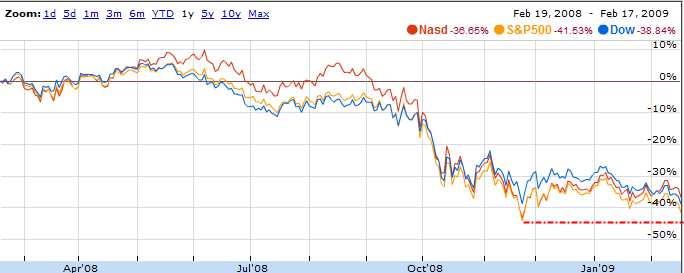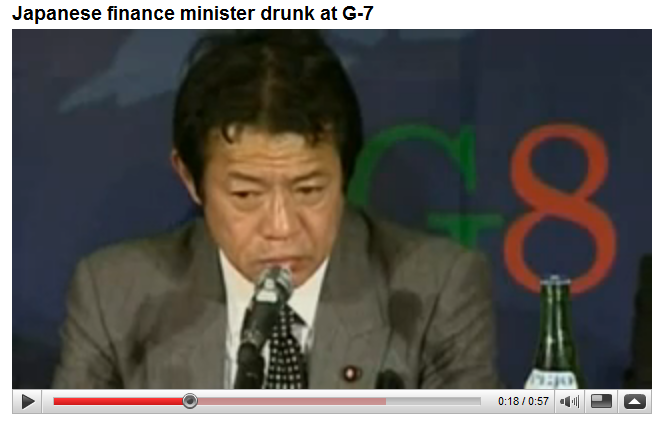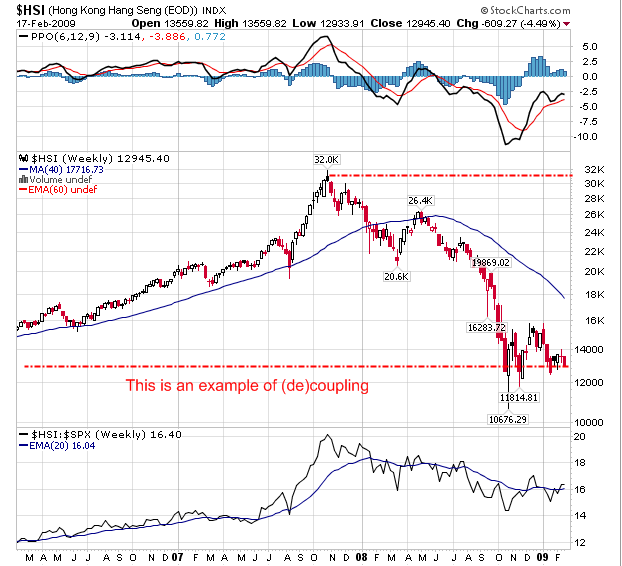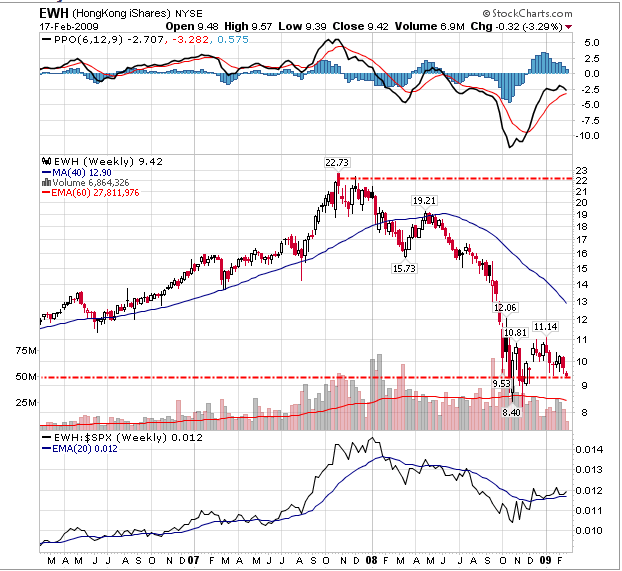Allen Stanford, Second Half Financial Recovery, and Decoupling: Delusional Economic Beliefs now Shattered.
Allen Stanford, the Texas billionaire is now under investigation by the SEC in what looks like more market shenanigans. The SEC is now stating that the fraud is of “shocking magnitude” and spans the world and involves $8 billion in securities that were allegedly falsely marketed to customers. Of course, the SEC is probably now turning up the fire on Allen Stanford even acknowledging that Stanford had been under investigation for “sometime” because of the major flak it is taking over uncle dubious, Bernard Madoff who operated a $50 billion Ponzi scheme that has now come to captivate the imagination of many Americans.
Yet the story of Allen Stanford is only shocking in the light of denial and downright naïveté that many had when the story of Bernard Madoff hit only a few months ago. Many were saying that this was the “fraud of the century” and nothing else could compare. Well guess what? Here we are at the well again. The SEC now feeling that it needs to make up for lost time, is now going to start pulling out a few sacrificial lambs to placate the masses. Make no mistake, the true fraud is what is being perpetrated by the Federal Reserve, Wall Street, and the U.S. banking industry.
At the heart of the Allen Stanford story is high-yielding CDs. Of course as we all know many banks and institutions that have now gone into the graveyard like WaMu and IndyMac were offering competitive rates on CDs only days before their demise in a last ditch effort to raise capital. “Sir” Allen Sanford is estimated to have a net worth of $2.2 billion and is 58 years old. Stanford is the chairman of the Stanford Financial Group of Companies. Ironically this guy made his first fortune in real estate in the early 1980s when he was based out of Houston, Texas. What a stunner. In 1983 Stanford had a default judgment of $31,800 slapped on him for back rent on a failed health club in Waco. Since that time Stanford has expanded on the greed that has fed this crony capitalistic enterprise and branched out to insurance and real estate. And now Stanford is showing us how to do the bezzle dance:
“(MarketWatch) Stanford’s Antigua-based bank, Stanford International Bank, sold roughly $8 billion of certificates of deposit to investors through a network of financial advisers by promising “improbable and unsubstantiated” high interest rates, the regulator said in a statement.
The rates were “supposedly” earned through the bank’s investment strategy, which “purportedly” allowed the bank to achieve double-digit returns on its investments for the past 15 years, the SEC added.
The agency also charged Stanford International Bank’s Chief Financial Officer James Davis and Stanford Financial Group’s Chief Investment Officer Laura Pendergest-Holt. “Stanford and the close circle of family and friends with whom he runs his businesses perpetrated a massive fraud based on false promises and fabricated historical-return data to prey on investors,” said Linda Chatman Thomsen, the SEC’s enforcement-division director, in a statement.
A U.S. District Judge entered a temporary restraining order, froze the defendants’ assets and appointed a receiver to marshal the assets, according to the SEC.”
This kind of stuff has been going on for years. So the first myth that we should dispel is that these are isolated cases. No. The system is rotten to the core and Stanford and Madoff are only the tip of the iceberg. We have other small time players like Art Nadel running around all over the country. The crony capitalistic system set this ecosystem up for them. Cases like that of Stanford only highlight the corruption embedded in the system. No country can survive on a debt enterprise and one where those in the financial industry can reach the pinnacles of stardom of being called “Sir” when you have people like Bernard Madoff running made up numbers and what is worse, people believed it because they too aspired to be part of the crony elite.
Second Half Financial Recovery
Where are all the delusional folks calling for a second half recovery? This mantra was going around for the last few months of 2008 with no basis in reality. Here we are, only a few weeks into 2009 and we are now back testing the market lows of November:
This is an incredibly fast drop. In fact, the NASDAQ is down 6.7% for the year, the S & P 500 is down 12.6%, and the Dow is down 13.9%. And we’re only in February! Keep in mind all this is happening with trillions and trillions of dollars being but at risk for the corrupt banking and finance industry and a $789 billion stimulus plan being signed. Even with all this, the market is now back to the lows seen in November! What do we need to do to get a brief recovery? Announce a $100 trillion bailout plan? I mean we are now in silly season here. The problem is our economy was dependent on a frat like force of financial wizards who didn’t care about the financial long-term stability of the nation. They built models to make a small select few richer and richer at the cost of the American taxpayer. After all, this money we are funneling to them is basically the insurance policy they bet on while feeding both Republican and Democratic legislatures. Their bets have paid off. Why else would such a inane plan like the TARP even get off the ground? Well if you leave it to a former Goldman Sachs crony to write the legislation, guess what is going to happen?
Even if there is a second half recovery it won’t feel like it for 90 percent of the American population. Those claiming and preaching a second half recovery are those already in these albatross industries and are getting bailout funds. Why not bailout Circuit City when we had the chance? Why not send Burger King some extra money? Just look at who is receiving bailouts and you’ll understand who is running the show.
The current phase we are in is what John K. Galbraith calls the “bezzle” stage. That is, we are now in the process of discovering the Madoffs and Stanfords and what they have been doing for years if we only had competent enforcers and politicians who would have had the guts to take a stance. Only now after things have gotten so rotten, do we take action. Yet the deed is done. I liken this to many California homeowners thinking their home was “worth” $600,000 only to realize that when they go to sell, they can only get $300,000. They lived a life of phony money and are now coming to terms with a brutal contracting economy.
And how can there be a second half recovery? The stimulus plan will take some time to get into the economy. Let us look at some of the key points:
-$1,000 child tax credit for low income families
-Middle-income and wealthy taxpayers will receive help from the Alternative Minimum Tax
-First-time homebuyer tax credit of $8,000
-Those receiving unemployment insurance won’t pay federal income taxes on the first $2,400 they receive
-Millions will receive an extra $13 a week in their paychecks starting in June
-$90 billion to infrastructure projects like repairing roads, waterlines, and bridges
-$42 billion to energy related investments
-$54 billion to help states with education expenses
-$25 billion for No Child Left Behind and other such programs
-$4 billion for the Head Start and early education program
These are only a few key points but all the above does is blunt the economic tsunami coming our way. How is this a second half recovery? What the above does is keeps us from going to soup lines and homeless shelters but a second half recovery it is not. The financial and real estate industries have hurt our country and economy so deep, that it will take years before we see a healthy economy. At least in this bubble, we have homes which are more valuable than tulips if you want to find to find a tiny silver lining. Needless to say, there will be no second half recovery.
Decoupling is Now Proven Wrong
Japan’s Finance Minister Shoichi Nakagawa has figured out how to deal with the current financial crisis. Get plastered:
Well shortly after his drunken news conference Mr. Nakagawa called it quits. Honestly, who could blame the guy? Japan is in a massive recession and last week, we learned that GDP contracted at its largest pace in 35 years. Why is this important? Japan is the number 2 economy in the world and you already know where we stand. Germany is also in a recession. And what about China? Let us look at their stock markets:
In fact, China is having more trouble in their markets! After all, the U.S. was the consumption machine for much of their exports. Europe was supposedly a backstop but they have bigger housing bubbles than the U.S. which is amazing in itself.
So this notion of decoupling is proven false. What other proof do you want? Take a look at the global stock markets and they are in tatters. The last time we had such synchronized global wealth destruction was during the Great Depression. People forget that the Great Depression was global in reach and wasn’t only isolated to the 1929 Crash on Wall Street. It was much larger and more complex than the Fed simply not stepping in. We had conflicts in Europe with Germany drowning in war reparations. You had a collapsing commodities market. You had rising unemployment in supposedly stable countries. So all these things entered into a perfect storm. It took us nearly a century to come back to something similar to that time and here we are again.
 Did You Enjoy The Post? Subscribe to Dr. Housing Bubble’s Blog to get updated housing commentary, analysis, and information.
Did You Enjoy The Post? Subscribe to Dr. Housing Bubble’s Blog to get updated housing commentary, analysis, and information.





 Subscribe to feed
Subscribe to feed






14 Responses to “Allen Stanford, Second Half Financial Recovery, and Decoupling: Delusional Economic Beliefs now Shattered.”
China has been pouring money into the stock market both directly and indirectly. The Chinese stimulus package has been diverted to stock buying in addition to direct government purchases to support share prices. Other Asian economies doing this include Singapore where the goverment has been staunchly defending the 1600 level on the STI (more excellent investing from Temasek after their stunning purchases of Merrill, among others).
Yes, the Perfect Storm 2 has arrived. What began in the U.S. has now permeated the rest of the globe. The epicenter of this housing/financial mess will prove to be the Westside of Los Angeles in Southern California, where appreciation WAS the most pronounced.
This summer will be the turning point…
http://www.westsideremeltdown.blogspot.com
http://www.santamonicameltdownthe90402.blogspot.com
I think we are all in trouble this time. Think about it, can you name a profession that they can actually tell the truth. Baseball players making obscene amounts of money, cant tell the truth. Politicians who at one time had to be held accountable to their constituents can’t tell the truth. Investment gurus can’t tell the truth. The list goes on and on.
Here is a sampling of what is going on…..Did you ever steal money from any of your clients? I cannot answer that question truthfully until you tell me what evidence you have on me that I did steal money. If you dont have anything on me then the answer is “no”. Oh, you have evidence, well wait a minute, let me modify my answer to conform with the evidence you do have.
Bye bye economy.
I think we’re good for a 3rd half recovery!
Bluntly put: people are dumb. I can’t tell how many times I heard people repeating this second half recovery pipe dream. They simply look at at the post WWII cyclical recessions and model their assumptions on them. The fact that the current situation is nothing like that does not sink in, or simply they refuse to see it. I had one guy tell me that we were fine, only the real estate and financial sectors were in trouble. There are only two problems with this statement: a) It’s not true, b) those two sectors effect pretty much all the others, consequently a)…
If this stimulus manages to slow down our economic death spiral we are lucky. Maybe the next one can do some more. In general, if we have a couple of bad years and then start to recover, we can consider ourselves extremely lucky. Worse scenarios are possible.
Decoupling… It reminds me how spectacularly right Peter Schiff was about the housing bust, and then how spectacularly wrong about everything else. Blinded by ideology.
Granted, there are definitely some parallels between what’s happening now and the events that transpired during the Great Depression. Discussing this seems to be in vogue during every economic downturn, at least as far back as I can remember.
Milton Friedman asserted in his Free To Choose series (in “The Anatomy Of A Crisis” episode) that the ’29 stock market crash was just another business cycle, and that following this were the bank runs (there was no FDIC then). He believed that the Fed could have stepped in, bought government securities on a large scale, and with those funds met the demands of depositors. People would have found out that their money was safe and this would have ended the bank runs, minimizing the bank failures. He also stated that the money supply had declined about 30% between 1930-33. Something to think about.
@ToadB
You’re right–Instead of assessing the damage and changing with the tide, some people still believe that the tide will somehow change to follow their most certain expectation, based on some hard and fast belief they have tied themselves to. All things follow greater forces than what any man believes. It’s like the weather–even armed with massive historical data, powerful computer models, brilliant intuition, and real-time observations, they can still not say with certainty there will be a vicious storm one night last week and 15 people will die.
Still, there is enough historical data, powerful computer models, brilliant intuition and real-time observations to prevent foolish decisions in economics, but we repeat the same cylces again and again.
“…they would not listen, they’re not listening still, perhaps they never will.”
One other quick observation:
These ponzi’s have also been ‘delivering’ unrealistic returns which have jaded expectations for all publicly held companies. For instance, heath care costs have been perversely driven by shareholder demands for 10% YOY gains. Since no one else can afford insurance, the only way to achieve those kind of gains is to raise prices YOY. Why can’t people be content with a nice fat profit? Why does it have to be unsustainable growth and returns? More dogma. Give me the derivative, not the integral. The whole thing was designed to fail.
I will take a counter view. These are the best of times. Yes it looks like the economy is out for the count, but given we are all globally in the same boat (sure some nations’s better than most), and as a country the US is starting to get real about money, phoeny scams, and wasteful spending (except that coming from the US government) I see lots of room for progress.
Comment by Ken T
February 18th, 2009 at 6:04 pm
Granted, there are definitely some parallels between what’s happening now and the events that transpired during the Great Depression. Discussing this seems to be in vogue during every economic downturn, at least as far back as I can remember.
Milton Friedman asserted in his Free To Choose series (in “The Anatomy Of A Crisis†episode) that the ‘29 stock market crash was just another business cycle, and that following this were the bank runs (there was no FDIC then). He believed that the Fed could have stepped in, bought government securities on a large scale, and with those funds met the demands of depositors. People would have found out that their money was safe and this would have ended the bank runs, minimizing the bank failures. He also stated that the money supply had declined about 30% between 1930-33. Something to think about.
_______________
(1) The stock maarket crash of 1929 did NOT cause the downturn. That had actually began back as far as ’26 and was slowly gathering steam. Manufacturing pulling back, sales pulling back…… The stock market was a symptom but not a cause. In fact the stock market had gotten the bubbliest as everything else slowed and people were looking for another means of get rich quick after Florida real estate poped.
(2) The Federal Reserve had extreme limitations on what it could or could not do in ’29 and until ’33 when FDR took the US off the gold standard as Great Britain , Sweden etc had previously done. Only major power stil ont he gold standard was France and it was hoarding gold.
>>
The Federal Reserve only had as much money available as it had gold. It couldn’t go out and lend more and more money to banks nor buy up stock because it had financial limits – aka how much gold it had on hand.
>>>
Deficit borrowing was most definitely NOT on Hoover’s agenda so that avenue of funds was foreclosed the the Fed Res and Treasury.
>>>
(3) Buy up STOCK and BONDS? Which ones? The ones where the bond issuance was floated on behalf of a town in Germany that was defaulting? Or the one where it was floated on behalf of a South American country that kept having revolutions and defaulting repeatedly on its debt?
>>>
It was the BOND defaults that sent the banks into a liquidity and solvency crisis – not the stock market. Banks had been merrily buying up dubious bond issuances with their depositors money on the theory that the bond salesmen wouldn’t lie. They were most fond of foriegn bonds of all the choices. And then those bonds started defaulting and their margins were being called and they couldn’t cover and on it went.
>>
The bank runs did NOT start the stock market crashed. They started when bonds began defaulting 2 years later. (Sort of like mortgages and credit cards to day – loans/bonds made to borrowers who couldn’t pay it back.)
>>>>
Like all of Friedman’s other theories, this one ignores reality when it contradicts his pie-in-the-sky ideas. That is whining that the Fed Res did not do the impossible when the constraints on what could be done were inflexible; and the 2 events (market crash & bank runs) were quite separate both in timing and cause.
@AnnS: Excellent lesson. That makes a lot of sense. Since we have now determined that the Constitution is just a piece of paper, the NRA II must be just around the corner, only it won’t be deemed unconstitutional this time…
@LauriL: Can you get me some of that stuff? I’d like to be happy about all this too, cuz I bet things will only get more better…I agree that our character should improve, and people’s sense of urgency will kick in. Everyone might start working together to keep the company they work for afloat. People might stop ripping one another off. There should be some benefit to all this. I hope so. How we gonna feed all the banquers, lowiars and reialturz though?
Interesting article on yahoo about Obama’s new plan to help homeowners:
The Risk from Underwater Homeowners
http://news.yahoo.com/s/bw/20090219/bs_bw/feb2009db20090218423745;_ylt=ApaGXNTxV5dp.M75p2Ywp0iyBhIF
The Obama Administration’s $75 billion homeowner-rescue plan offers a lot of help to people in imminent danger of losing their homes. It does far less for those who are deep underwater on their mortgages but have the wherewithal to keep making their monthly payments. And that could be a problem — not only for those homeowners themselves, but for the banking system and the economy in general.
Here’s the dilemma: Many homeowners owe more on their mortgages than their homes are worth, and — rightly or wrongly — increasing numbers of them may decide to give up and mail in the keys. The taboo against reneging on debts already shows signs of fading in hard-hit markets like Phoenix and Las Vegas. More abandonments would increase losses for lenders while damaging the vitality of neighborhoods.
There’s not much in the Homeowner Affordability and Stability Plan announced on Feb. 18 to deal with this looming problem.
-snip-
Obama’s plan is broader and stronger than Hope for Homeowners, the unwieldy, mostly voluntary program passed by Congress last summer. On the other hand, that’s not saying a lot. Hope for Homeowners has refinanced a microscopic 25 mortgage loans so far. Even a thousandfold improvement over that would still constitute failure for the Obama Administration. That’s why this plan may require some changes in the months ahead.
(more at link)
—————————————————————————————————————
Wow, Hope for Homeowners….what a success….helped a whopping 25 families.
Nice piece on using the Andrew Mellon approach (let zombies fail and…” It will purge the rottenness out of the system”. (PruBear,Hutchinson) Maybe instead of carrying this broken down SUV along the highway we might have to walk for a while…We might have to walk anyway, but be exhausted, cuz that SUV is leaking like a SIV. If we’d been a little more ‘Mellon-cholly’ we could have avoided thise ‘Supply-side folly’.
@AnnS – another great report. Thanks.
Hi, I suggest this link
http://www.vsizer.com/index.php?action=show&idComparison=18278
where you can vote, comment and find out what the web thinks about Peter Schiff vs James Galbraith
Leave a Reply